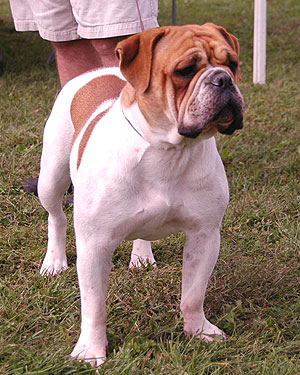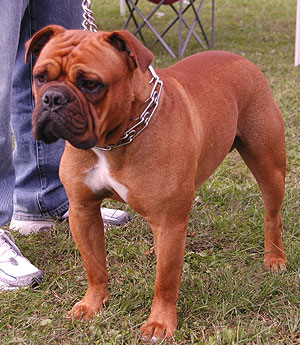Olde English Bulldogge

 Not to be confused with the recently established Leavitt Bulldog, even though both breeds were developed by David Leavitt, the Olde English Bulldogge was created in Pennsylvania in the early 1970's by crossing the modern English Bulldog with the English Bullmastiff, American Pit Bull Terrier and American Bulldog, with intentions of re-creating the long-lost working variety of original British baiting bulldogges, but without the aggression and tenacity for which they were known for in the past. By the end of the decade, the hard work of raising many experimental litters and carefully selecting the best specimens for further breedings has paid off and the Olde English Bulldogge was starting to breed true. David Leavitt was joined in his efforts of establishing his newly formed breed by Ben and Karen Campetti in the first half of the 1980's, a couple from Massachusets who became the first breeders of the Olde English Bulldogge in the country approved by the breed founder.
Not to be confused with the recently established Leavitt Bulldog, even though both breeds were developed by David Leavitt, the Olde English Bulldogge was created in Pennsylvania in the early 1970's by crossing the modern English Bulldog with the English Bullmastiff, American Pit Bull Terrier and American Bulldog, with intentions of re-creating the long-lost working variety of original British baiting bulldogges, but without the aggression and tenacity for which they were known for in the past. By the end of the decade, the hard work of raising many experimental litters and carefully selecting the best specimens for further breedings has paid off and the Olde English Bulldogge was starting to breed true. David Leavitt was joined in his efforts of establishing his newly formed breed by Ben and Karen Campetti in the first half of the 1980's, a couple from Massachusets who became the first breeders of the Olde English Bulldogge in the country approved by the breed founder.
While David Leavitt was working on improving his stock, the Campettis put their efforts in promoting the Olde English Bulldogge, mostly through exhibiting their dogs in Shows, as well as by using them for therapy work and in obedience trials with great success. This resulted in the breed's rise in popularity in the United States, which in turn created the need for more breeders. In order to ensure correct breeding practices and protect the breed's interests, the Campettis and Leavitt founded the Olde English Bulldogge Association in 1985, which implemented a code of ethics for the new breeders, devised a breed Standard and kept track of the pedigrees and health records of all registered dogs.
The Olde English Bulldogge was welcomed as a successful new creation, a breed superiour to the modern English Bulldog, both in terms of health and agility, but much less aggressive or dominant than the baiting dogs it was a re-creation of, as well as a more stable dog than some of it parent breeds. The OEB was also well-accepted outside of America, most notably in Canada, Britain and Europe, but it was its home country that completely fell in love with the new breed.

 Although its primary intented role was that of a companion breed, the Olde English Bulldogge's genetic makeup, agility and physical appearance made it popular as a personal protection dog, which, coupled with the rise of other "alternative" working bulldogge re-creations which profited on the use of the OEB name, had resulted in David Leavitt essentially abandoning his creation and leaving the OEBA to focus on developing what would eventually become the Leavitt Bulldog breed. Over the course of the 1990's, the Old English Bulldogge continued its rise to fame, but it also suffered from its name being employed for a wide variety of similar creations, many of which neither looked nor acted the part the OEB should represent. This led to the formation of the Olde English Bulldogge Kennel Club in 2001 by Tim Kelly, Karen Campetti, Ray Schneider, Louis Colon and other breeders and enthusiasts who felt that the OEBA had essentially failed their breed, wanting to ensure the preservation of the original bloodlines and the integrity of the breed as whole. The OEBKC was recognized by the ARBA registry as the official Breed Club in America, ensuring that only OEBKC-registered dogs are accepted as pure Olde English Bulldogges.
Although its primary intented role was that of a companion breed, the Olde English Bulldogge's genetic makeup, agility and physical appearance made it popular as a personal protection dog, which, coupled with the rise of other "alternative" working bulldogge re-creations which profited on the use of the OEB name, had resulted in David Leavitt essentially abandoning his creation and leaving the OEBA to focus on developing what would eventually become the Leavitt Bulldog breed. Over the course of the 1990's, the Old English Bulldogge continued its rise to fame, but it also suffered from its name being employed for a wide variety of similar creations, many of which neither looked nor acted the part the OEB should represent. This led to the formation of the Olde English Bulldogge Kennel Club in 2001 by Tim Kelly, Karen Campetti, Ray Schneider, Louis Colon and other breeders and enthusiasts who felt that the OEBA had essentially failed their breed, wanting to ensure the preservation of the original bloodlines and the integrity of the breed as whole. The OEBKC was recognized by the ARBA registry as the official Breed Club in America, ensuring that only OEBKC-registered dogs are accepted as pure Olde English Bulldogges.

 The Olde English Bulldogge is a handsome, intelligent and even-tempered Molosser, a good choice for a family pet and urban companion, gentle with children and tolerant of strangers. However, early socialization is required to help control confrontational nature of some dogs, especially males. Naturally territorial, the OEB makes a good watchdog, but is no way an aggressive or vicious breed. It is fairly trainable, although some examples can be quite stubborn. This is a powerful, well-boned and athletic breed, with a wide chest, broad back and a large, round head, with strong jaws and a reasonably short muzzle. The eyes are round and dark, with black pigment on the eyerims. The broad nose must be black in colour. Ears can be "button" or "rose" in type, with the rose type being preferred. Unlike the modern screw-tailed English Bulldog, the OEB has a naturally longer tail, either straight or "pump handle" in type.
The Olde English Bulldogge is a handsome, intelligent and even-tempered Molosser, a good choice for a family pet and urban companion, gentle with children and tolerant of strangers. However, early socialization is required to help control confrontational nature of some dogs, especially males. Naturally territorial, the OEB makes a good watchdog, but is no way an aggressive or vicious breed. It is fairly trainable, although some examples can be quite stubborn. This is a powerful, well-boned and athletic breed, with a wide chest, broad back and a large, round head, with strong jaws and a reasonably short muzzle. The eyes are round and dark, with black pigment on the eyerims. The broad nose must be black in colour. Ears can be "button" or "rose" in type, with the rose type being preferred. Unlike the modern screw-tailed English Bulldog, the OEB has a naturally longer tail, either straight or "pump handle" in type.
The coat is short, flat and shiny, coming in a variety of typical bully colourings, both solid and particoloured, including fawn, red, brown, brindle and white. Average height is around 19 inches.
